PinotFile: 6.31 July 9, 2007
|
Ski Green ValleyIn my second life, I want to come back as someone like Gerald Bybee. He and his wife Shaun, own a piece of paradise in the Green Valley appellation of Sonoma, near the town of Sebastopol. On their total habitat of 86 acres, they have a thriving Pinot Noir vineyard of 14 acres and a large lake with a professional water ski slalom course! To me, this is nirvana, since I grew up waterskiing from a very young age. Forwards, backward, barefoot, pyramid, jumps, you name it, I did it on water skis. I used to say, “Hit It!” in my sleep. When I recently visited the B Vineyards & Habitat, I wanted to get out on that pristine lake right there and then. (See aerial photo on page 2).
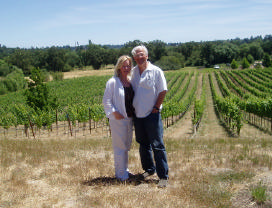 Gerald Bybee is an award-winning advertising photographer and fine-artist who has done a number of photoshoots for wineries. Shaun Bybee is a former model, CEO of Make-up Studio U.S.A. and President of the Board of Summerfield Waldorf School in Santa Rosa. About 12 years ago, Gerald and Shaun wanted to leave their home in San Francisco to acquire a wine country property. They came upon a neglected agricultural and open-space habitat that had originally been the home of Miller Dairy, the last certified raw milk producer in Sonoma County. The original dairy processing building still stands on the property and now serves as a place for equipment and barrel storage, but one day may be converted into the B Winery. Although initially, they had no plans to grow grapes, it seemed only natural since their property sat adjacent to the 30-year-old Hartford Family Arrendell Vineyard. The area presented many challenges because it sat in the nutrient-rich and water-laden flood plain near Atascadero Creek. The usual vineyard pests, birds, gophers, and deer were plentiful. The microclimate did offer ideal conditions for Pinot Noir: morning fog, sandy-loam, and Goldridge soils, and one of the coolest climates in the Russian River Valley. The aerial photo of the B Vineyards & Habitat shows Hartford Family Arrendell Vineyard in the foreground, the B lake, pond, and open space habitat as well as several blocks of B Pinot vines, with the estate residence in the distance. 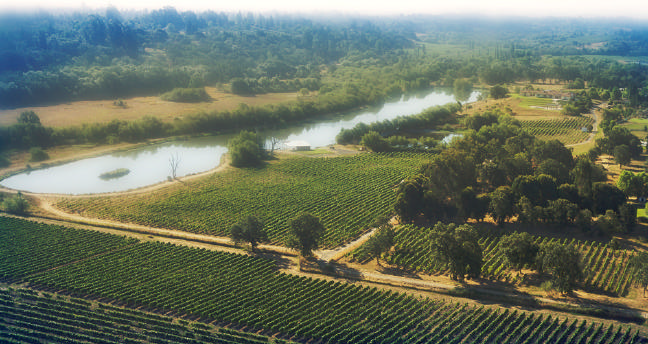 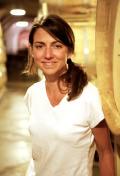 Each of the blocks in the B estate vineyard is picked and vinified separately. A fine rosé is made from a selected block. Winemaking is traditional with an emphasis on elegance and complexity. Shaun says that the B wines “are meant for those with not only a great understanding of Pinot Noir and all of its intricacies, but also an appreciation of the dedicated farming practices that ultimately determine what ends up in the glass.”
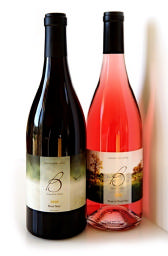 2006 B Vineyards & Habitat Rosé of Pinot Noir 13.0% alc., 120 cases, $24. · A dry rosé with an appealing light crimson color, this is a thoroughly satisfying aperitif or summer food wine. The flavors are driven by red fruits, primarily ripe strawberries, with a hint of spice and herbs. Strawberry Fields Forever.
2005 B Vineyards & Habitat Green Valley/Russian River Valley Estate Pinot Noir 13.9% alc., 210 cases, $55. Hand picked, carefully sorted grapes underwent de-stemming, cold-soak and gentle pressing using a small Italian basket press. The wine was aged 10 months in caves using lightly toasted new and used French oak barriques, and bottled-aged 6 months before release. · This is one great Pinot powered by wild strawberries, cherries and exotic oak highlights in the aromas and flavors. A hint of root beer adds interest. The texture is supple and there is plenty of bright acidity. This is one of those Pinots that you can sniff for 20 minutes after the glass is emptied and only a small dollop remains in the bottom. You simply can’t take your nose out of the glass. Dreamy musk, crushed cherries, spice and freshly-sanded mahogany waft from the glass. It is enough to make a grown man smile from ear to ear.
B Vineyards & Habitat wines may be purchased from the website at www.bpinot.com or www.bybee.com. Sign up for the mailing list here, check out the blog, and be sure and view the beautiful photography of the property taken by Gerald. If you like wildlife and Pinot, make an appointment (707-823-9040) to visit and taste. You might see Shaun walking the vineyards row by row with Suzanne as she does every week or Gerald out on the lake catching a ride. 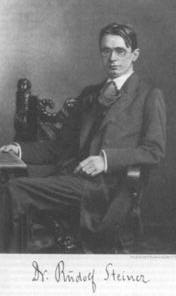
EMTU Estate WinesJohn and Chris Mason produce a single estate Pinot Noir from a dry-farmed, 2 acre certified organic vineyard located in Forestville at the juncture of the Russian River Valley and Green Valley AVA’s of Sonoma County. They live on their property, tend to their estate Labyrinth Vineyard just out the back door of their house, and control all of the winemaking. Nothing really unusual about this, but let me tell you about these extraordinary people and their dedication to humanitarian causes. The Masons (both of them had the sir name Mason before marriage, but were unrelated and thus the name EMTU which is a phonetic spelling of M2) have been international relief workers since 1999 when they went to Kosovo to build homes and shelters in remote villages as part of relief efforts for homeless families. John is a retired paramedic and Chris a retired worker in the health care field with a master’s degree in dietary science. Every year in the winter months, they close up the farm while the vines lay dormant and the wine is tucked away in barrels, and travel to a foreign country where they are needed. They have been in Gujarat, India helping in the aftermath of a disastrous earthquake, in Bamenda Highlands of Cameroon assisting AIDS educators, and in Chaman, Pakistan where they established medical clinics in two border refugee camps and provided medical services to over 30,000 refugees. In 2005, they founded the Labyrinth Foundation for Disaster Relief to allow them to operate independently or in cooperation with other aid organizations. All of the profits from EMTU wines go to their charitable foundation. (The Masons are pictured below in front of their small winery). 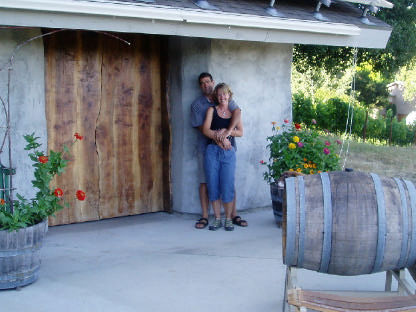 If during the growing season the vine seems out of balance, both shoots and fruit are removed to allow the vine to fully ripen the grapes. The grapes are harvested when the ideal balance of physiological ripeness, acids, tannins and sugar have been reached. This will be a different mix each year, based on climate, and the resulting wine will vary from year to year. It is the Mason’s goal to avoid producing a homogenized product, but rather a consistently excellent wine that fully expresses the nuances of the site from which it originates and the conditions under which it matured. A small labyrinth pattern of vines was planted in one corner of the vineyard leaving a small central space open that serves as a place of contemplation and serenity among the vines. The name, Labyrinth Vineyard, is derived from this unusual planting. The Masons honed their winemaking talents and refined their style over 10 years, producing “garagiste” wine at their home. The first commercial release of estate Pinot Noir was 2004. The current release is the 2005 vintage. Production was small in 2005 (148 cases), but the eventual goal is 500 cases. They also make a small amount (25 cases) of dry rosé from a few rows of Merlot planted on the property.
2005 Emtu Estate Wines Labyrinth Vineyard Russian River Valley Pinot Noir 14.0% alc., 148 cases, $36. Grapes were picked in the early morning at 24.6° Brix and a pH of 3.36. A 3 day cold soak followed. Fermentation was started with inoculation of Assmanshaussen yeast, punched down by hand, and basket pressed into 3-year-old neutral French oak barrels without settling. Aged in barrel a total of 18 months and bottled unfiltered and unfined. · This wine is a classic Pinot lover’s cup of tea. Alluring spiced red fruits in the nose lead to cherry-infused flavors that dance elegantly on the palate. The lively acid cleans up the finish. Basic, but basically quite good.
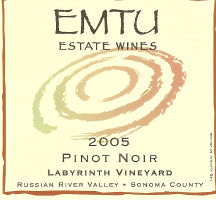 2004 Emtu Estate Wines Labyrinth Vineyard Russian River Valley Pinot Noir 14.6% alc.. The grapes for this wine were picked at 25.6° Brix. · This resulting Pinot Noir is fruit-driven and bold in style. The color is deep ruby and the rich wild berry flavors linger on the palate for some time. This is a good wine, but not the preferred style of the Masons.
EMTU Estate Wines welcomes visitors for a private tour and tasting (707-887-1239). Sit on the patio with the Masons, delight in the view, and enjoy these very interesting people. As the back label of their wines states, “They are dedicated to the principles of quality, process, and balance, infused with science.” Ask to see the barn owls and red shouldered hawks they receive from the Bird Recovery Agency in Sonoma County. They raise the birds until they are able to function on their own and then release them into the local environment. There is no web site, but John welcomes inquires through his e-mail at jrm1023@hotmail.com. The wines may be purchased by calling directly or e-mailing John. Remember that when you purchase EMTU wines, you not only get to enjoy a bottle drink of Pinot, you are supporting the Mason’s humanitarian efforts in third world countries.
Another Winner from J. LynneLast year I wrote about and recommended the 2004 J. Lynne Russian River Valley Pinot Noir. The 2005 version is even better and recently won a medal at the 16th Annual New Orleans Wine and Food Experience Fleur De Lys Wine Competition (only 5 Pinot Noirs were awarded medals out of a total of 62 medals). 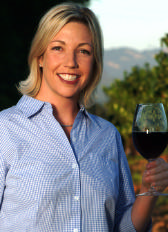 Jennifer (Jen) Lynne Wall is well known as the winemaker for Barefoot Wine Cellars. Barefoot wines have a dedicated following among millennials and they proudly call themselves “Barefooters.” The label’s tagline says it all, “Get Barefoot and have a good time!” Barefoot Wine Cellars (owned by Gallo) participates in 1,000 charitable events annually. In my younger days it was Lancers and Mateus that got me started in wine, today it is Barefoot wines that are introducing a new generation to wine. Over two million cases of eight different California-sourced varietals ($6), seven different reserve wines (including a reserve Pinot Noir - all $14) and two California Champagnes ($9) are produced annually. Interestingly, Davis Bynum’s father developed the name in 1965, calling his wine “Barefoot Bynum. Burgundy” and sold it in jugs. In pursuit of more higher end Pinot Noir, Bynum dropped the popular label in 1972. In 1986 the Barefoot Cellar brand was revived by Michael Houlihan and Bonnie Harvey who bought the brand from Davis Bynum. Barefoot Wine Cellars really took off in 1995 when Jen was hired to become the winemaker. In 2005, Gallo purchased the brand and with Gallo’s financial backing and marketing expertise, the label has continued to prosper. I haven’t met Jen yet, but from what I read about her I should. The recent Quarterly Review of Wines said, “All the clichés emerge amidst her gusto: she could talk a dog off a meat truck, sell refrigerators to Eskimos, and so on.” Like a number of winemakers I know, she began college with the intention of going into medicine. After graduating from University of Santa Cruz, she headed instead to Sonoma County and became hooked on becoming a vintner. She learned her winemaking craft under the distinguished winemaker, Erin Green, now winemaker at Pahlmeyer (see article in this issue). Since 1995, Jen has accumulated over 2000 medals for Barefoot Wine Cellars. Like most accomplished winemakers, however, she yearned to have her own label. With the assistance of husband Mike, she debuted a Pinot Noir and Chardonnay in 2003 and accolades have quickly followed. The J. Lynne Pinot Noir is sourced from the Cameron Ranch in the Russian River Valley. The original ranch was purchased in 1905 by the Reverend Donald Cameron. 120 acres was used to raise chickens and 58 acres to grow hops. Later, apple, peach and prune trees were farmed. In 1922, Donald’s sons Cameron and Bruce became the owners and carried on the farming tradition. In 1952, the hops were removed and later the apples as well. The first grapevines, 3½ acres of French Colombard, were planted in 1960. Wes (Charles’ son) took over the ranch in 1961 and in 1964, the ranch was split and 35 acres became known as the Wes Cameron Ranch. More and more grapes were planted in the following years and today the ranch is owned by Wes’s widow, Dorothy, and operated and managed by her son Butch Cameron and son-in-law David Cornelssen. Cameron Ranch is located just east of the Martinelli Winery. The ranch has a large year-round creek (Mark West Creek) on the northern border which is used to irrigate in the late winter and early spring months to protect against frost. Wes Cameron was a pioneer in the use of irrigation for frost protection. The ranch is currently planted to 5.5 acres of French Colombard, 16.5 acres of Pinot Noir and 11 acres of Chardonnay. The entire ranch is set up on a trellis system. Wes Cameron was one of the first grape growers in Sonoma County to train a vineyard to grow on a trellis system.
 2005 J. Lynne Russian River Valley Pinot Noir 13.5% alc., 415 cases, $25. The grapes from the Cameron Ranch were picked at 25.9° degrees Brix on October 8, 2005. The fruit was presorted, de-stemmed and cold soaked for 3 days. The wine was aged for 6 months in a combination of 1, 2 and 3 year-old French oak barrels mostly from the Vosges forest. · This wine is seamless from start to finish. Aromas of oak-spiced crushed cherries lead to flavors of demure red Pinot fruits perfectly spiced. The texture is velvety. This fine Pinot exemplifies the holy trinity of Pinot Noir: elegance, balance and purity of fruit. Color me Pinot.
J. Lynne Pinot Noir can be found in fine wine retail stores mostly in California, Louisiana, Minnesota, and Wisconsin (distributor is Republic National Beverage Company). The 2006 vintage will be released later this summer and production will be almost doubled. The website is www.jlynnewines.com. Jen sent me some photos of her grapes at harvest and her winery operation at harvest which you may find interesting (below and pages 8 and 9). I would encourage you to travel to a wine region during harvest and breath in the heady aromas of freshly-crushed Pinot Noir. It is an exciting and celebratory time of the year in the vineyards and many wineries will be happy to let you hang out and observe the harvest. 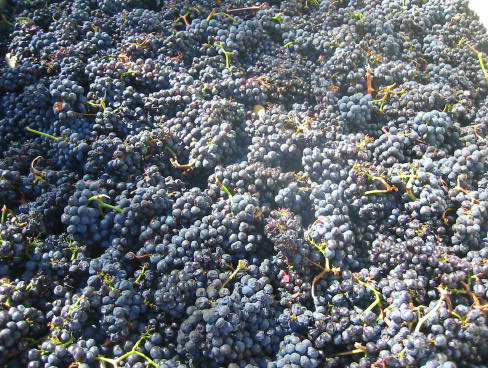 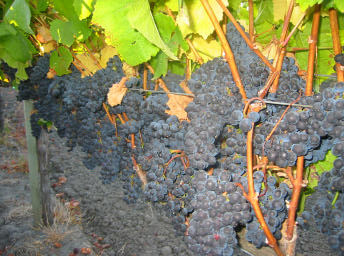 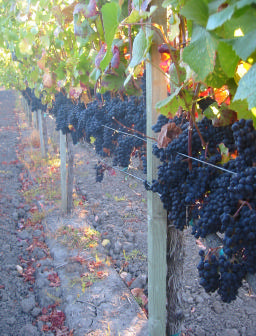 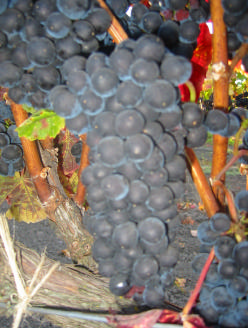  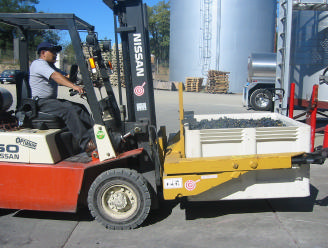 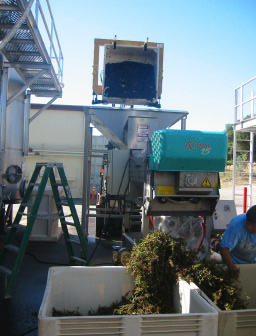 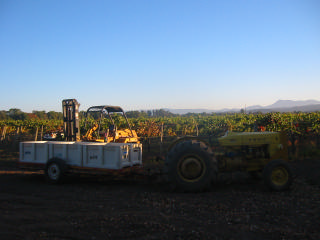 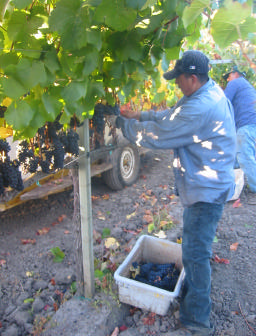 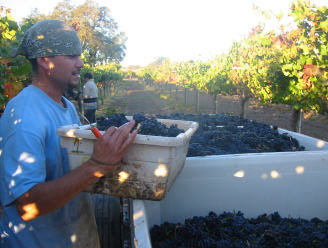
Pahlmeyer Pinot NoirPahlmeyer is among the top echelon of Napa wineries and the label is synonymous with consistently superb Chardonnay, Merlot and Bordeaux-styled wines. Like other luminous Napa wineries such as Joseph Phelps and Del Dotto, Pahlmeyer has ventured to the far western reaches of Sonoma County to farm Pinot Noir on the edge. In 1998, Pahlmeyer found Wayfarer Farm, a small organic fruit and vegetable farming operation owned by Dorothy and David Davis who sold organic produce to San Francisco Bay Area restaurants such as Chez Panisse and Greens. The ranch extended over 70 acres and according to Pahlmeyer President Ed Hogan, was a “fairytale landscape of slopes, with not a single flat stretch in sight.” Like other notable vineyards in this region such as Flowers and Hirsch (Hirsch can be seen looking south from Wayfarer Farm), the property is situated two ridges in from the Pacific Ocean. The elevation is 1,125 feet. The vineyard is a 45 minute drive along twisting narrow two lane roads from Jenner, where the Russian River Valley empties into the Pacific Ocean. I can vouch for its isolated but scenic location as I visited Wayfarer Farm recently with winemaker Erin Green.  Farming in an isolated region like this is no picnic. Fortunately there are enough vineyards in the area now that vineyard management companies have crews in the area. Ulises Valdez is the vineyard manager. Pahlmeyer’s viticulturalists (headed by Amy Warnock) check on the vineyard weekly . Erin lives in Santa Rosa and must travel from home 1½ hours to the vineyard and 1½ hours to Pahlmeyer’s winery on Atlas Peak in Napa. So much for the romance of winemaking. The photos below show the rolling hillside terrain of the Wayfarer Farm vineyard. There is very little flat land on which to plant a vineyard along the Sonoma Coast. The air is pristine and one can see for miles in all directions.  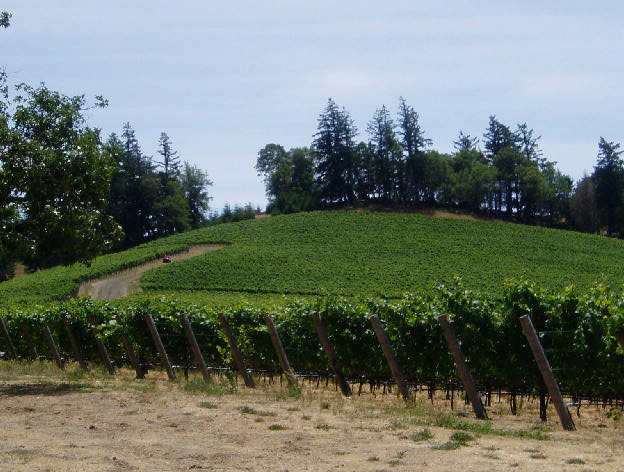 
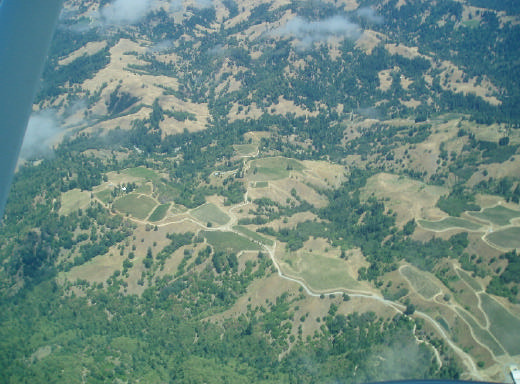
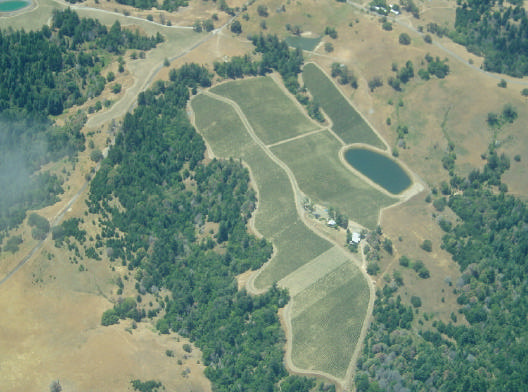 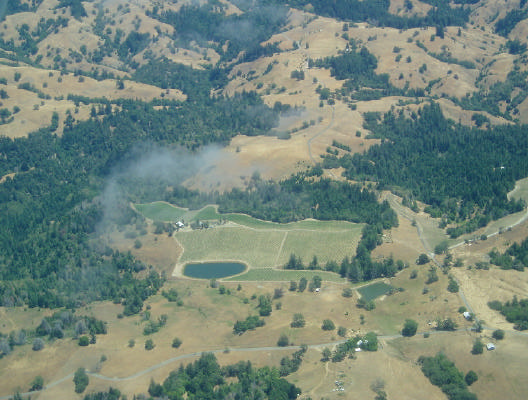  Pahlmeyer will be releasing two Pinot Noirs this year. The 2005 Jayson Pinot Noir was released in April, and the 2005 Pahlmeyer Pinot Noir will be available in September. The wines as yet are not truly estate in that other vineyards supplied some of the fruit. As the vineyard matures, other sources will gradually be phased out. I tasted both Pinot Noirs with Erin Green at Wayfarer Farm and also sampled the Jayson Pinot Noir in my usual fashion at home.
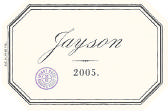 14.9% alc., 3,330 cases, $65. The grapes were crushed whole berry and de-stemmed. A cold soak was followed by fermentation with native yeast, gentle pressing, 9 months of barrel aging in 67% new French oak, and bottled unfiltered. The Jayson Pinot Noir is considered a “declassification” of the Pahlmeyer Pinot Noir, but the quality of the lots that remain after assembling the final blend of the Pahlmeyer Pinot Noir is still stellar. · The sexy nose of dark cherries, blackberries, mushrooms and earth stands out. The flavors mimic the aromas with an added spice and woodsy influence in the background. After four hours, a little spice comes forth in the nose and a hint of root beer enlivens the flavors. Everything is nicely balanced with the tannins well-concealed and the alcohol well-integrated. No question this is a broad-shouldered middleweight Pinot Noir with a rich core of fruit, but it dances softly on the palate.
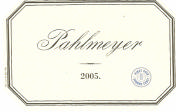 14.9% alc., 14.9% alc., 1,400 cases. The grapes were sourced from Goldridge, Pellegrini and Dutton vineyards as well as Wayfarer. Winemaking is the same as for the Jayson except barrel aging was 15 months. · The color is deeper than the Jayson. This wine has a massive concentration of dark wild berry and plummy fruit. The nose is shy but hints of earth, meat and crushed blackberries. This Pinot is brooding at this stage and the oak tannins are noticeable on the finish. This will need some cellar time to fully emerge (drink the Jayson now while the Pahlmeyer ages). A muscular heavyweight that is built for the long haul and will thoroughly please fans of the hedonistic style of Pinot Noir.
Pahlmeyer Pinot Noirs may be ordered directly from the winery (www.pahlmeyer.com, 707-255- 2321) or through the network of restaurant partners and retail merchants around the world. A special website has been set up for further information: www.pahlmeyerpinotnoir.com.
Athair: Pinot Noir With a Gaelic TwistAthair is a collaboration between two winemakers, Tom Keith and Jim McMahon. Tom says he discovered the Threshold of Heaven in Sonoma Valley in 1977. Through the years he raised a family and made wine at home, garnering multiple medals for several varietals including Pinot Noir. After 34 years operating an international men’s apparel business, he decided to partner with his son-on-law, Jim McMahon, to form Athair (the gaelic word for “father”). Jim’s winemaking career began at Kenwood Winery in the Sonoma Valley where he developed a love for Pinot Noir and a familiarity with the Pinot Noir vineyards of the Russian River Valley. He started as a laboratory technician and rose in the ranks to assistant winemaker. After nine years at Kenwood, he moved to Luna Vineyards in the Napa Valley as assistant winemaker where he is currently employed.. In 2004, he married Courtney, whose father, Tom, became his business partner in Athair. Jim is the winemaker for Athair, while Tom handles most of the marketing, sales, and winery grunt work. The pair’s Irish heritage and strong family traditions are reflected in the name Athair. Jim chose the name as a tribute to the fathers who have played such a profound role in his life. Jim says, “As you pour your first glass, raise it in a toast in honor of your father.” Around Father’s Day this year, Athair was giving 20% off on all wine purchases. Jim’s winemaking is centered around patience. Like so many top Pinot Noir producers today, he realizes that most of the work is done in the vineyard, and once the grapes reach the winery, the winemaking process requires only prudent message and careful handling to bring out the sensuality of this most delicate of grapes. Winemaking is traditional with minimal pumping and a single racking. The wine is aged in 25% new and 75% neutral French oak. Jim says the aim of his wine crafting process is to make a Pinot Noir “that will have a ten year shelf life.”
2005 Athair Russian River Valley Pinot Noir 14.5% alc., 600 cases, $35. This wine is composed primarily of grapes from the Calegari Vineyard on Eastside Road in the Russian River Valley and the Cleary Ranch Vineyard in Freestone. The way-cool silk-screened bottle is unique for California Pinot Noir. · I will get to the point: flat-out terrific. Aromas of cherry, rhubarb, toast and cola keep your nose in the glass and flavors of cranberry, Bing cherry and vanilla keep you coming back for another sip. There is deft use of oak and the texture is velveteen. Harmonious and complete, this is the stuff that Russian River dreams are made of.

Paradise Ridge Has the ViewA number of people had told me about Paradise Ridge Byck Family Estate, but until recently I had never visited. As you head east from Hwy 101 on Fountaingrove Parkway, you encounter multiple apartment and condominium developments, but no hint or expectation that a winery sits in the neighborhood. A small sign directs a left turn on Thomas Lake Harris Drive and the road winds up a hillside away from the populous below. An entry drive takes you past Paradise Meadows, where three large sculptures come into view done by Bay Area artist, Gale Wagner. As you travel further along the road, you encounter a number of unusual sculptures hidden amongst the trees and part of an annual exhibition of outdoor sculpture. The sculpture garden is really more of a outdoor museum and is reason enough to visit this scenic property. As you arrive at the hospitality and event center at the top 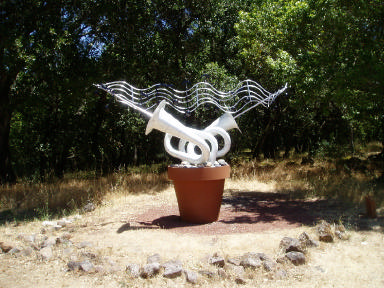 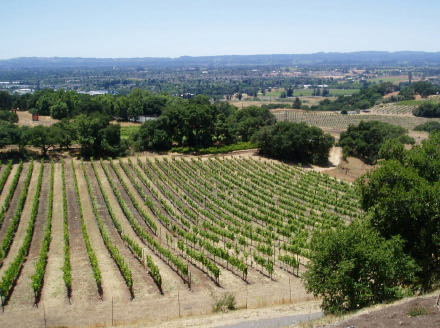 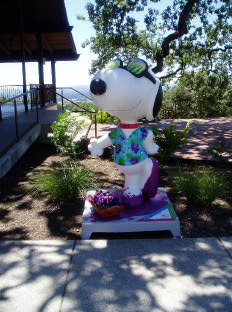 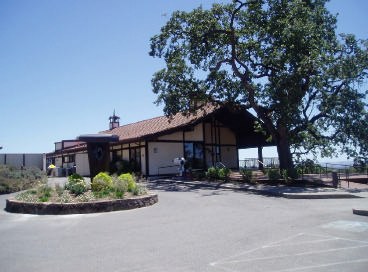 The nearby Fountaingrove Winery was part of a 700-acre ranch initially owned by Thomas Lake Harris. At the turn of the century, Fountaingrove produced 90% of the wine in Sonoma County. The winemaker, Kanaye Nagasawa, was known as “The Grape King,” and became one of the most respected leaders of California’s burgeoning wine industry. According to Charles L. Sullivan, writing in A Companion to California Wine, Nagasawa eventually took control of the winery and after his death, his heirs sold it in 1937 to Errol MacBoyle who restored the Fountaingrove label. Hanns Kornell made sparkling wine for the label and the winery’s still wines under the direction of Kurt Opper were legendary. Joseph Swan said the 1937 Zinfandel was the finest Sonoma wine he had ever tasted. John W. Haeger (North American Pinot Noir) states that Fountain Grove grew Pinot Noir (or something close to it) back in the 1930s and a 1939 Pinot Noir was served at a Wine and Food Society tasting at New York’s Pierre Hotel in 1845. Steve Heimoff notes in A Wine Journey Along the Russian River that a 1935 Fountaingrove wine was labeled Sonoma Pinot Noir. In 1953, all 400 acres of vineyard were pulled out and developers have taken over the ranch in recent years. When you travel along Fountaingrove Parkway, you can see the large red Fountaingrove barn. The label is now owned by Martini & Pratti Winery.
2004 Paradise Ridge Elizabeth & Henry’s Vineyard Russian River Valley Pinot Noir 14.4% alc., 350 cases, $24. Elizabeth & Henry’s Vineyard lies at the southeastern corner of the Russian River Valley close to Paradise Ridge. Planted in 1995, the vines are meticulously cared for by Henry Siebert and produce small, flavorful berries. · Dark ruby in color. Enticing aromatics of blackberry pie and oak spice. The flavors are a mélange of red and blue fruits. The whole package is nicely crafted with a soft mouth feel and a pleasing persistence and length on a clean finish.
Paradise Ridge wines (they produce a number of other excellent wines other than Pinot Noir) may be purchased on the winery’s website at www.paradiseridgewinery.com. A number of special events are hosted at the winery including “Wines & Sunsets in Paradise,” on Wednesday evenings April thru October. Locals are encouraged to bring a picnic and enjoy Paradise Ridge wines while watching spectacular sunsets from the winery’s decks and terrace. I have included a map if you wish to visit, for finding Paradise is a bit tricky. 4545 Thomas Lake Harris Drive, Santa Rosa, CA 95403. 707-528-9463. 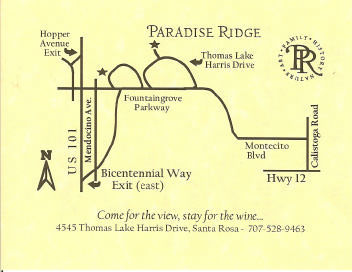
Life is a Sojourn Pinot NoirPlato said “Life is but a sojourn. Enjoy the best of it.” Craig Haserot (wine taster) and Erich Bradley (winemaker) are two buddies who met on the tennis courts of Sonoma and decided to take Plato’s advice. They formed Sojourn Cellars and released their first Pinot Noir and Cabernet Sauvignon in 2004. Their handcrafted wines have won considerable praise from the wine press. The wines are made at the Audeless Estate Winery in Glen Ellen, California, where Erich is the fulltime winemaker. His winemaking is New World in style and the resulting wines are bold and expressive.
2005 Sojourn Cellars Sonoma Coast Pinot Noir 14.6% alc., 240 cases, $36. This wine is a blend of grapes from two Sangiacomo Vineyards - Roberts Road and Vella. · A medium-bodied Pinot Noir which needs air time to express itself. The nose is replete with rhubarb, exotic woods, toast and Xmas spice. The ripe Pinot fruits tend to the dark flavors and are rustic and tart. The finish delivers a little heat but it is not over the top.
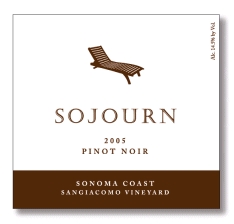 2005 Sojourn Cellars Sangiacomo Vineyard Sonoma Coast Pinot Noir 14.5% alc., 230 cases, $48. The Sangiacomo Vineyard that supplies the grapes for this wine in Cotati in the cool northern end of the Petaluma Gap. The wine is a blend of Dijon clones 115 and 777. · The nose is shy initially and needs plenty of swirling. Xmas spice, especially cinnamon, and leather become apparent. The flavors tend toward darker fruits with a hint of raisin. There is more richness in the mid-palate and the finish than the wine above and the alcohol is better integrated. The texture is smooth and the finish offers a nice soft landing.
Sojourn Cellars Pinot Noirs are available through a winery mailing list and also may be purchased by e-mail at orders@sojourncellars.com. The owners welcome visitors for private tasting and tours of the Sonoma Valley (707-933-9753). The website is www.sojourncellars.com. 
Summer Wine Events
 Michael Bonaccorsi was the twentieth American to receive the Master Sommelier Diploma and became a respected sommelier at Spago Restaurant in Los Angeles, California. On Sunday, August 5th, 2007, the annual event benefiting the Michael Bonaccorsi Scholarship Fund at the University of California Davis School of Viticulture will be held at Wally’s Wine Store, 2107 Westwood Blvd., Los Angeles, CA. This will be the 4th such event. Initially, Jenne Bonaccorsi thought this would be a one-time scholarship when she asked people to donate instead of sending flowers after her husband’s untimely death. Now the scholarship fund has risen to over $200,000 without large donations and her goal is to be able to pay the entire tuition for a student, maybe even two students eventually. The event is outside under a big tent from 12:00 to 4:00 PM and tickets are $95 in advance, $125 at the door. At least 50 wineries from the Central Coast will participate. Last year, the list included Alban Alma Rosa, Ambullneo, Brewer-Clifton, Ken Brown, Native 9, Paul Lato, Whitcraft, Talley Vineyards, Sine Qua Non, Calera Wine Company, Fiddlehead Cellars, Sea Smoke, Au Bon Climat and more. Food will be served up by top restaurants including Hitching Post II, Spago Beverly Hills, Lucques/AOC, Sona, Campanile and more. For tickets and more information: www.bonaccorsi foundation.com, or www.wallywine.com.
On August 17-19, the 12th Annual Grape to Glass Weekend will be held in the Russian River Valley. Sponsored by the Russian River Valley Winegrowers, it is a weekend of winery and vineyard tours, educational seminars and tastings, scenic bike rides, a magical mystery bus tour, a special luncheon and a down-home barbecue. Register online at www.rrvw.org or call 707-521-2535 for an event brochure.
A dozen chefs from the Sonoma County Culinary Guild and 30 Sonoma County wineries will work in concert under majestic oak trees on Saturday, September 15, 2-5:30 PM at this annual fundraiser for the Wine Library Associates of Sonoma County. There will be a new offering of silent and live auction items. The event returns to Richard’s Grove and Saralee’s Vineyard in the heart of the Russian River Valley. Those in search of book bargains can browse the Wine Library’s book tent. Tickets are $45 for members of the Wine Library Associates and the Sonoma County Culinary Guild and $50 for nonmembers. Reservations may be made by phone at 707-431-2898.
Tantara Winery is celebrating its 10th year of operation with a special party at the winery on Saturday, July 28th. Tantara Winery is located in the midst of the renowned Bien Nacido Vineyard located about six miles east of the town of Santa Maria. The celebration will start with a barrel tasting of the 2006 vintage conducted by Bill Cates and Jeff Fink followed by dinner in the courtyard of the Ontiveros Adobe. This historic 150-year-old adobe is located just south of the winery. The dinner will feature a menu prepared by Cantinetta Luca, which is a hot new restaurant in Carmel, California. The special menu will be paired with library and recent vintage Tantara wines including some large format bottlings. The number of attendees is limited to 100 and is expected to sell out. The event is $150 per person inclusive. For reservations, contact Tantara’s office manager, Maria Acosta, at Tantarawinery@cs.com.

Short notice on this one which is this coming weekend, July 12-15, 2007. Some tickets may still be available for some events. There are a number of terrific sessions to consider like “Pinot Noirs of the Historic Vineyards of Santa Barbara County,” and “Single Vineyard Wine Symposium featuring Melville Winery and Nickel & Nickel.” A dinner and vertical of Domaine de la Romanee-Conti La Tache will be held at the home of Maurice & Susie Wedell, owners of Wedell Cellars ($2,000). The major events are held at Dolphin Bay Hotel and Residences, Shell Beach, California. For registration, visit www.centralcoastwineclassic.org. or call 805-544-1285.
Carneros Wine Alliance Visitors GuideThe growers and vintners of the Carneros Wine Alliance have put together a very nice map and directory of the wineries in the Alliance. Also included are wineries located outside of Carneros in the Napa Valley who source grapes from the Carneros AVA. The directory includes winery tasting room hours and/or appointment instructions and the featured wines of each winery. To get your copy, contact the Carneros Wine Alliance at Carneros Town Center, 4048 Sonoma Highway, Napa, CA 94559 or phone 707-253-2678.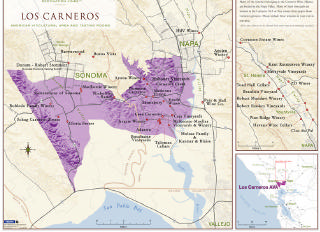
Classic Oregon Pinot Noir Vineyards Lost to CaliforniaAs reported recently in the Oregon Wine Press, Mark Tarlov, managing partner of California winery The Evening Lands (TEL) acquired a long-term lease for the Seven Springs and Anden Vineyards, with an offer to purchase the vineyards. TEL plans to produce Pinot Noir from its two vineyards in California - one in Santa Rita hills, the other the Occidental Vineyard on the Sonoma Coast (previously sourced by Kistler for it’s Cuvee Elizabeth), and the Seven Springs Vineyard in Oregon. TEL is a business partnership between French partners who own a domaine in Burgundy, a restaurateur from New York, sommeliers and Dorothy Cann Hamilton, founder and CEO of the James Bead Foundation. Seven Springs Vineyard was planted in 1982-1989 and was owned by husband and wife Al MacDonald and Joni Witherspoon until their divorce in 2001. In the past prominent Oregon wineries made vineyard designate Pinot Noir from this vineyard including Bethel heights, St. Innocent, and Evesham Wood. They will be sold little or no grapes in the future. Cristom’s contract for grapes runs out in 2008. St. Innocent was known for its Seven Springs Vineyard bottling and purchased over one-third of the fruit from this vineyard, along with fruit from Anden Vineyard. St. Innocent and others will now have to develop more of their own vineyards or look to other fruit sources such as the vineyards of Premier Pacific, which will have thousands of acres reaching maturity in the coming years. Acquisition of prime Pinot Noir vineyards by corporate and partnership entities will continue at a heightened pace in the future. Many small boutique Pinot Noir producers lacking vineyards of their own are at the mercy of handshake agreements which will often not stand up to the grower’s economic pressures and the acquisition machine. The scramble for prime Pinot Noir grapes will only intensify in the near future. |